History
- Introduction
- The beginnings - Art Nouveau & Red Propaganda (1895 - 1919)
- Art Deco & Modernism (1920 - 1944)
- The distinctive poster art of a short-lived democracy (1945 - 1949)
- Socialist Realism and the continuity of the modern poster (1950 - 1955)
- A cavalcade of styles & techniques (1956 - 1970)
- The low-culture and the neo avantgarde (1971 - 1990)
The beginnings - Art nouveau & Red propaganda (1895 - 1919)
Take a look at our inventory from this period by: clicking here.
The history of poster art began in the second half of the 19th century, in the big cities of Western Europe, London and Paris. As a result of the industrial revolution, enormous amounts of goods were being produced. These new products needed advertisement, and the huge empty walls and columns of the rapidly growing cities offered a perfect platform for posters to be displayed. By then, the technique of poster art was refined: the lithography or stone printing was already invented by Alois Senefelder in 1796. Designing posters soon became an important form of art thanks to the great French master Jules Chéret, who revolutionized the printing technique by reducing the color scale to 2-3 colors. By the end of the century, poster art emerged in the big cities of Europe, and became an independent form of art.
In Hungary, the history of poster art started in 1885. This was the year when the preparations for the General Exhibition in Budapest had started. The exhibition was the central event of the celebrations related to the development of the Hungarian state. Hence every field of the local economy and culture was represented at the event. The organizers took care of the advertising of the prominent ceremony; they ordered a monumental poster from a significant academic painter of the time, Gyula Benczúr. This became the first Hungarian poster. Benczúr intended to represent every detail and segment of the exhibition: agriculture, industry, science and culture all appear symbolically. Therefore, the composition became very congested with the graphics and with the extremely lengthy text. It demonstrates the style of the 19th century's historicism, and it rather resembles a baroque document, than a modern poster. The negative critics regarding the poster suggested that a more modern visual language should have been used. Disappointingly, no good modern posters were designed for the Millennium festive of Hungary in 1896.

Nandor Barany - Budapest Zoo 1911 Hungarian vintage poster
The change in this situation was accelerated by a big international exhibition in 1898, organized by the Museum of Applied Arts. The show, called “Modern art” was a triumph of the Art Noveau, where a large collection of posters was also presented: the works of the best poster artists from all around Europe. The exhibition made it easy to understand the basic rules and the unique visual language of the modern poster. A good poster must possess high artistic quality where picture and text shall appear as a unit; the composition has to be clear, simple but dynamic and not crowded; the image must be spectacular but there is no need for applying the rules of perspective or plasticity. The poster became modern in a sense that the function is what determines the aesthetics, not the other way around. In the beginning, Art Noveau was a style that fitted perfectly for the purposes and functions of the poster.

Afra Crystal Palace mind reader fortune teller mystic vintage poster Hungarian 1910s
On this very first international exhibition in Hungary, this style was the most dominant, it appeared on the works of the few Hungarian artists, whose posters were exhibited (for example János Vaszary). Vaszary’s participation demonstrates how effectively the painters contributed to the birth of poster art. The greatest Hungarian painters of the period created the first excellent posters in a decorative and symbolic Art Nouveu style, mainly for exhibitions. Along with Vaszary, József Rippl-Rónai, and the painters of the artist colony of Nagybánya, such as Károly Ferenczy or Béla Iványi-Grünwald are worth mentioning. Nagybánya, a small mining town in Transylvania, hosted the first Hungarian artists, who painted outdoors, who brought a revolution to art life by plein air naturalism. This artistic revolution is noticable on their exhibition posters as well. They also ahow the influence of the post-impressionist tendencies, the peinture of the Nabis, Gauguin, etc. These influences resulted a new, symbolical artistic world. The flat-like, decorative figures are dominant on other artist's posters as well, such as on Adolf Fényes’s. Besides the painters, applied artists, Pál Horti for example, also developed a decorative Art Nouveu poster style.

Janos Vaszary - International Spring Art Exhibition 1899 Hungarian Art Nouveau poster
By the end of the 1890s, the practice of using foreign bianco designs with Hungarian text dropped off, and the local poster design was established. The height of the Art Noveau period concurred in this field with the development of Hungarian poster art. It defined the work of Hellmann Mosonyi-Pfeiffer: he used decorative, strong contour lines, flat colored fields and the Japanese woodcuts’ way of space arrangement (for example: Parádi Gyógyvíz, Brázay sósborszesz). Beautiful women figures were common not only on his works, but on the posters of the successful salon painter, Lajos Márk as well (Kristály savanyúvíz, Wolf Hugó bankháza, Vígszínház - Mici hercegnő). In these early years, a former lithographer, Ferenc Helbing became one of the most popular poster designers, and later an important teacher of the profession.
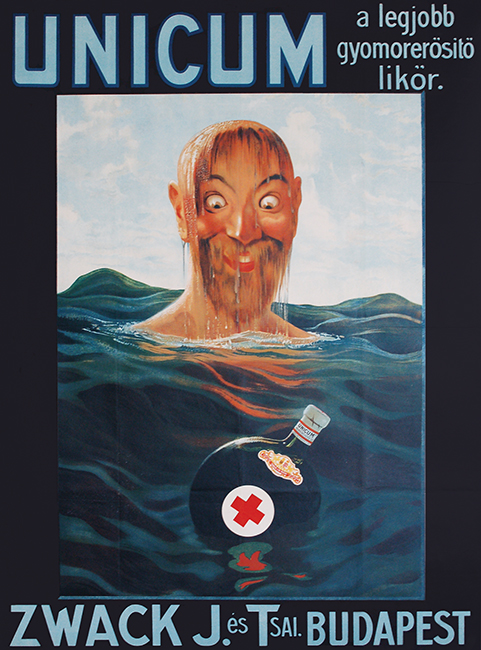
Zwack Unicum 1909 Hungarian vintage poster
In the High Art Noveau period, two masters of poster art are outstanding due to their exceptional talent: Géza Faragó and Mihály Biró. They were two completely different characters: Faragó was the master of the decorative Art Noveau, his style is close to Mucha’s, while Biró is famous for his suggestive and powerful propaganda posters. Faragó had worked in Mucha’s studio in Paris for years, and after returning to Hungary, he developed a beautiful, dreamlike Art Noveu or so-called ‘secessionist’ style. He often depicted beautiful and elegant ladies with excellent, airy drawing and soft pastel colors (an eminent work of his is the Tungsram poster that reflects the art of the French Nabis and postimpressionism). He also enjoyed drawing very funny caricatures of typical members of society (aristocrats, soldiers, young dandies and dames, and even priests), or of himself, often as a figure of Pest’s nightlife, which was his most commonly recurring topic. Faragó had an absolutely unique sense to create breathtaking decorative designs infusing them with an absolutely charming humorous tone.
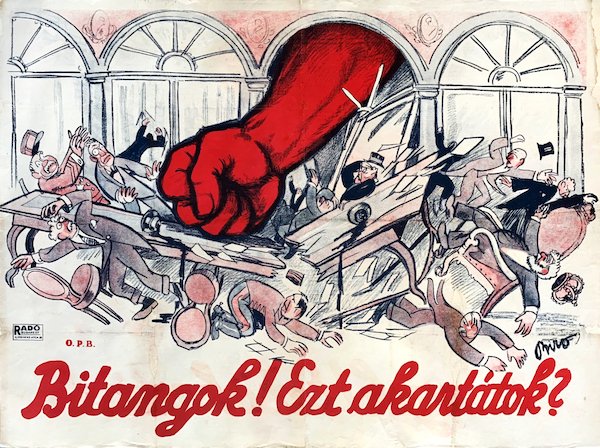
Mihaly Biro - Scoundrels! Is this what you wanted? Hungarian Soviet Republic - Treaty of Trianon 1919 vintage Hungarian communist propaganda poster
Biró’s posters received international attention and acclaim already at their time, and he is one of the most prominent masters of Hungarian poster art to this day. His works are defined by his strong leftist-proletarian conviction. He created his most famous symbolic red-hammer-wielding man poster in 1912 for Népszava (People’s Voice, a leftist magazine). He was able to incorporate the masses of the working class into one monumental symbol. Although he is best known for his propaganda posters, Biró designed some of the best commercial posters of the era (Palma heels, Let’s go to the Edison movie theatre!).
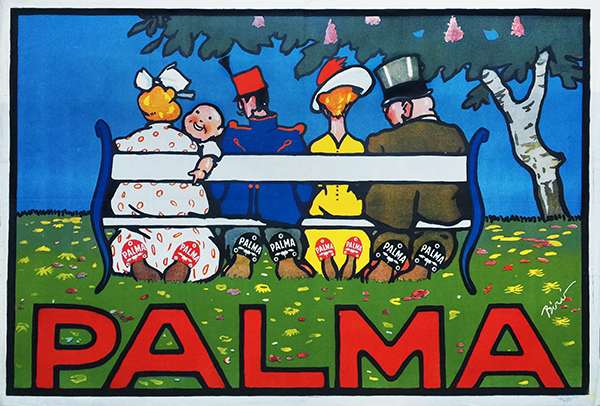
Mihaly Biro - Palma heels 1911 Hungarian vintage poster
Biró has designed several posters for the Social Democratic Party, most of them are extremely powerful, expressive designs. These are his most sought-after works. The political poster was a new genre in the beginning of the 1910’s, no wonder that Biró is considered to be its founder. In 1919, he worked and designed posters for the new soviet state during the 133 days of the Hungarian Soviet Republic, so after its demise, he had to emigrate. This is why his career continued abroad: in Austria and Germany.
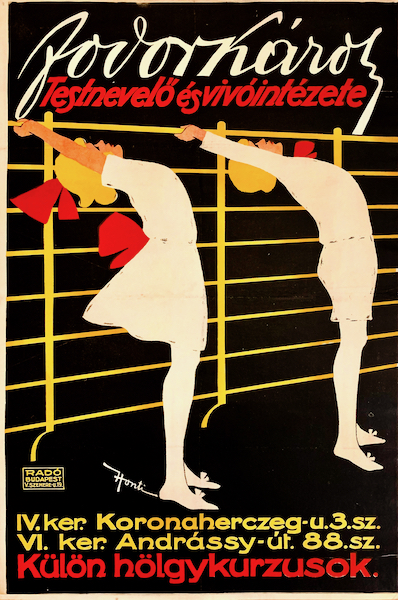
Nandor Honti - Karoly Fodor's Physical Education and Fencing Institute 1910s - 1920s vintage Hungarian commercial advertising poster
During the 1910s, cinema was a popular form of pastime, which increased the need for movie posters and other forms of film advertising. Imre Földes was one of the first artists to specialize in this field. He had excellent drawing skills that defined his highly decorative works, which is detectable on his designs, like the poster for Mascotte Bar. Földes often cooperated with Lipót Sátori, who had a more painting-based approach. They both created wonderful representations for popular silent movies. Besides them, Árpád Ékes has created excellent movie posters in a very unique style.

Imre Foldes - Mascotte Bar 1910s Hungarian poster
By the mid-1910s, the poster became an essential form of mass communication. Along with Art Noveau, other tendencies have emerged in poster art, such as the German invention, the Plakatstil or Sachplakat. Influenced by Lucien Bernhard’s very solid style, concentrating on the representation of the product’s image, Márton Tuszkay created outstanding posters (Fonott bútorok). The 1910s brought the first wave of avant-garde; some of the emerging new trends had their effect on the development of poster art.

Imre Foldes - Store your furs and carpets a the Cold Store 1911 Hungarian poster
In Hungary, the first avant-garde artist groups were born in the 1900s and 1910s, such as The Eight or the Activists – the latter group was an advocate of modern poster art. Sándor Bortnyik’s poster for the exhibition of the Ma (Today) journal from 1919 is an outstanding work of art that bears the influence of cubism, expressionism and futurism. One of his earliest avant-garde poster is Lygeia, which is promoting a book.
Between 1914 and 1918 the first world war gave much work for the poster designers: propaganda became a strategic issue. Posters were published to promote the war loans, charity events, or to sell the hundreds of memorial books and souvernirs that told about the Great War. Almost every artist took part in the accelerated propaganda work, such as Földes, Biró, Faragó and Tuszkay.
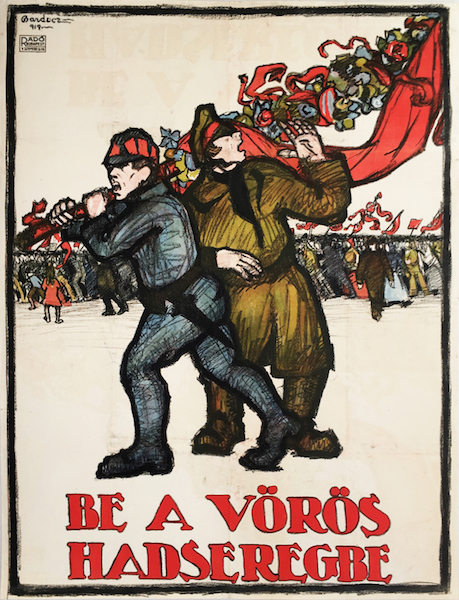
Arpad Bardocz - Join the Red Army 1919 Hungarian Soviet Republic porpaganda poster
In 1919, with the rise of the Hungarian Soviet Republic or Hungarian Republic of Councils, came a short-lasting golden age of the political poster. Years of war resulted in general discontent, which lead to a revolution, and finally to a communist putsch in 1919. For the new communist leaders, propaganda was a top priority: they ordered huge numbers of poster designs, which were printed in enormous scale and numbers. Every artists of the Hungarian avant-garde were convinced utopian leftists, and they were all working for the new government. Róbert Berény, an artist of the Eight, and Béla Uitz, a member of the Activists working close to Lajos Kassák have designed two classic propaganda posters (Fegyverbe! – To Arms! and Vörös katonák előre – Red Soldiers Advance!), but painters like József Nemes-Lampérth and János Kmetty, or Bertalan Pór created also exceptional pieces, just like Mihály Biró, Ödön Dankó Marcell Vértes or Jolán Szilágyi, among others. Their posters adopted motives from Biró’s earlier works, and they have learned from the avant-garde tendencies, mainly from expressionism. Hungarian political propaganda became immensely powerful.
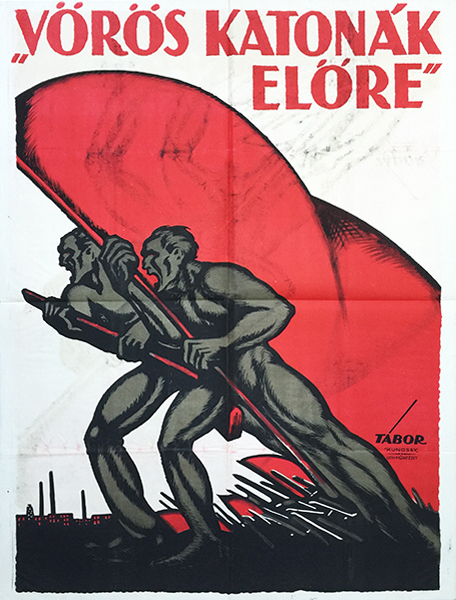
Janos Tabor - Red soldiers advance 1919 Hungarian Soviet Republic Communist propaganda poster
The Soviet Republic of Hungary fell after 133 days, and Miklós Horthy soon became the country’s new governor. Nearly all the great poster artists had to emigrate from Hungary, due to their involvement in the Hungarian Soviet Republic. For the next regime, bolshevism (and the Jews) became the scapegoat for every problem of the defeated and devastated country. The new political system’s propaganda was defined by the famous sportsman and artist Miltiades Manno. His posters draw from Biró’s works by using solid political symbols and monumental figures representing the society (for example: Horthy!). Some of Manno’s work are paraphrases of the posters of Biró, for instance the red-hammer-wielding man is quite often represented (in a negative context of course), sometimes even with supposedly semitic features, which signals the growing anti-Semitism in political propaganda.
The first period of Hungarian poster art between 1885 and 1919 was a golden age of Art Nouveau and contains the outstanding propaganda posters of the Hungarian Soviet Republic. The old historicist manner w as defeated by Art Noveau, the concurring tendency of the age. Mihály Biró and Géza Faragó are undoubtedly among the greatest poster artists, and there were numerous others. Many talented artists were working during these years, like Márk, Mosonyi-Pfeiffer, Vaszary, Helbing, Fényes, Tuszkay, Földes and Sátori, just to mention a few, creating wonderful posters and graphic design.
Take a look at our inventory from this period by: clicking here.